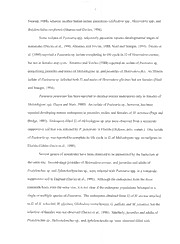
Biological control potential of Pasteuria penetrans PDF
Preview Biological control potential of Pasteuria penetrans
BIOLOGICALCONTROLPOTENTIALOFPASTEURIAPENETRANS By ZHONGXIAOCHEN ADISSERTATIONPRESENTEDTOTHEGRADUATESCHOOL OFTHEUNIVERSITYOFFLORIDAINPARTIALFULFILLMENT OFTHEREQUIREMENTSFORTHEDEGREEOF DOCTOROFPHILOSOPHY UNIVERSITYOFFLORIDA 1996 Copyright1996 by ZhongxiaoChen ToYanpingandMin. ACKNOWLEDGMENTS IamdeeplyindebtedtoDr.DonaldW.Dickson,chairmanofmycommittee,forthe financialsupport,guidance,encouragement,andfriendshiphegavemethroughoutthisstudy. I expressmyappreciationtotheothermembersofmycommittee,Drs.RobertMcSorley,DavidJ. Mitchell,J.HowardFrank,andJonC.Allen,fortheirvaluableguidance,suggestions, encouragement,andfruitfuldiscussions. IthankDrs.GroverC.Smart,Jr.,RobertA.Dunn, RobinM.Giblin-Davis,andHenryC.Aldrichforreadingmymanuscriptsandproviding suggestions,andfortheirkindness. SincerethanksareextendedtoDr.SenyuChenandMr. TomE.Hewlettfortheirfruitfulandjoyfuldiscussions,friendship,encouragement,and assistance. Specialthanksgotomywife,YanpingWu,andmydaughter,MinChen,fortheir patience,support,love,andencouragementthroughoutmystudy. IV TABLEOFCONTENTS Page ACKNOWLEDGMENTS iv LIST OF TABLES vii LIST OF FIGURES viii CHAPTERS 1. INTRODUCTION 1 Peanut Root-Knot Nematode 1 Biology 1 Distribution and Importance 1 Symptoms and Diagnosis 3 Management 4 Pasteuria penetrans 4 Historical Background 4 Members of Pasteuria 5 Biology of Pasteuria penetrans 8 Life Cycle 8 Sporogenesis 9 Systematics and Phylogeny 9 Host Records 10 Host Specificity 23 Cultivation 24 Ecology of Pasteuria penetrans 25 Temperature 26 Moisture 27 pH 28 Environmental Survival 28 Natural Enemies 29 Pasteuria penetrans as a Biological Control Agent 30 Biological Control Potential 3 Mode of Action 39 Objectives 39 2. QUANTIFICATION OF ENDOSPORES IN TOMATO ROOT MATERIAL 41 Introduction 41 Materials and Methods 42 Results and Discussion 45 .. 3. SOIL APPLICATION OF ENDOSPORES FOR MANAGEMENT ROOT-KNOT NEMATODES ON PEANUT 51 Introduction 51 Materials and Methods 52 Results 56 Discussion 60 4 MECHANISMS OF SUPPRESSION OF MELOIDOGYNEARENARIA RACE 1 BY PASTEURIA PENETRANS 66 Introduction 66 Materials and Methods 67 Results 71 Discussion 74 5 ESTIMATING INCIDENCE OF ATTACHMENT OF PASTEURIA PENETRANS ENDOSPORES TO MELOIDOGYNE SPP. USING TALLY THRESHOLDS 78 Introduction 78 Materials and Methods 79 Results and Discussions 82 6. ULTRASTRUCTURE, MORPHOLOGY, AND SPOROGENESIS OF PASTEURIA PENETRANS 89 Introduction 89 Materials andMethods 90 Results 94 Discussion 108 7. SUMMARY 118 APPENDIX. EFFECT OF AMMONIUM NITRATE AND TIME OF HARVEST ON MASS PRODUCTION OF PASTEURIA PENETRANS 121 LIST OF REFERENCES 133 BIOGRAPHICAL SKETCH 148 LISTOFTABLES Table page 1.1 Described genera of endospore-forming bacteria and their DNA base composition 11 1.2 Updated list of nematode hosts and geographical distribution of Pasteuria spp 12 1.3 Some experiments using Pasteuria penetrans for the control of plant-parasitic nematodes 31 2.1 Comparison of six methods for quantification of endospore concentrations of Pasteuria penetrans from tomato roots 47 3.1 Summaryof analysisof variance results for effects of Pasteuriapenetrans, as comparedto noninfestedcontrols, onMeloidogynearenaria race 1 andpeanut yields 58 4.1 Effects of Pasteuria penetrans on population densities and galling byMeloidogyne arenaria race 1 and on peanut yield per microplot in 1994 72 4.2 Effects of Pasteuriapenetrans on population densities and galling byMeloidogyne arenaria race 1 and on peanut yield per microplot in 1995 73 5.1 Parameters from linear regression of the number of endospores attached per second-stage juvenile (ln(zn)) as a patropdiofrfteiroenntofTjvuavleuneisles with < Tendospores attached (PT) ,85 5.2 Confidence interval half-widths (d) associated with the estimation of number of endospores attached per second- stage juvenile (m) from the proportion of juveniles with <difTfeernednotsposraemspleattsaizcehsed(n()PT) at different Tvalues with 87 6.1 Diameter and height of sporangia from four isolates of Pasteuria penetrans 97 6.2 Diameter and height of sporangia of isolate P-120 of Pasteuria penetrans sporangia grown on two tobacco cultivars and on two Meloidogyne species 99 VII LISTOFFIGURES Figure page 2.1 Regression of the number of endospores attached to second- stage juveniles (J2) of Meloidogyne arenaria race 1 to endospore concentrations of Pasteuria penetrans 50 3.1 Biologicalcontrol of peanut root-knotnematode, Meloidogyne arenariarace 1, using the obligate, endospore-forming, bacterialparasite Pasteuriapenetrans 57 3.2 Effectof Pasteuriapenetransinoculumlevels onMeloidogyne arenariapopulationandpeanutyield in 1994 59 3.3 Populationchanges of Meloidogynearenaria race 1 and Pasteuriapenetransin 1995 61 3.4 Relationshipbetweenthe percentageof second-stagejuveniles (J2) withattachedendospores andpopulationchanges of Meloidogynearenariarace 1 onpeanut 62 5.1 Analysis of the relationships between the means (m) and the variances (s) associated with m using Taylor's power law....84 6.1 Mature sporangia of Pasteuriapenetrans 95 6.2 Lateral view of sporangia and early sporogenous stage of Pasteuriapenetrans 96 6.4 Sporangial wall and exosporium of Pasteuria penetrans 101 6.5 Top view of endospores of Pasteuria penetrans attached to the cuticle of second-stage juveniles of Meloidogyne arenaria race 1 102 6.6 Different developmental stages of Pasteuriapenetrans within the pseudocoel of a single female 103 6.7 Mycelium of Pasteuria penetrans 105 6.8 Early sporogenous stages of Pasteuria penetrans 106 6.9 Sporogenous stages of Pasteuria penetrans 107 6.10 Late sporogenous stages of Pasteuria penetrans 109 6.11 Endospore of Pasteuria penetrans in the late sporogenous stage 110 6.12 Maturation of Pasteuriapenetrans endospores Ill 6.13 Amature endospore of Pasteuria penetrans 112 6.14 Line drawing of sporogenesis in Pasteuria penetrans, compared with Bacillus thuringiensis 113 Al Effect of ammonium nitrate on Pasteuriapenetrans grown on Meloidogyne arenaria race 1 127 A2 Effect of harvest time on Pasteuria penetrans grown on Meloidogyne arenaria race 1 13 IX AbstractofDissertationPresentedtotheGraduateSchool oftheUniversityofFloridainPartialFulfillmentofthe RequirementsfortheDegreeofDoctorofPhilosophy BIOLOGICALCONTROLPOTENTIALOFPASTEURIAPENETRANS By ZhongxiaoChen December,1996 Chairman: D.W.Dickson MajorDepartment: EntomologyandNematology Biologicalcontroloffersanalternativeorsupplementalmanagementtactictochemicalor culturalcontrolofplant-parasiticnematodes.Onebiologicalcontrolagentthathasshowngreat potentialforsuppressingfieldpopulationsofmanyplant-parasiticnematodesisPasteuriaspp. Thismicroorganismisamycelial,endospore-forming,bacterialparasiteofroot-knotnematodes. Onespecies,Pasteuriapenetrans,whichisreportedtobespecificforroot-knotnematodes, Meloidogynespp.,waschosenforstudyofitsbiologicalcontrolpotentialagainstMeloidogyne arenariaonpeanut. Theobjectivesweretoquantifythedensitiesofendosporesintomatoroot material,todeterminelevelsofendosporesrequiredtocontrolM.arenariaonpeanut,to M determinethequantitativesuppressionof arenariaonpeanutbyP.penetrans,toestimate incidenceofattachmentofendosporestoMeloidogynespp.usingtallythreshold,andtostudy theultrastructure,morphology,andsporogenesisoffourisolatesofP.penetrans. Mortar disruptionandmachinedisruptionwerethemostaccuratemethodsforquantificationof endosporesintomatorootmaterial. Whenendosporeswereinoculatedinmicroplotsat0,1,000, 3,000,10,000,and100,000endospores/gofsoil,rootgallsandpodgallswerereducedat10,000 and100,000endospores/gofsoil.ThequantitativesuppressionofM,arenariaonpeanutbyP.
